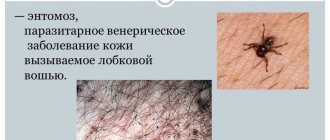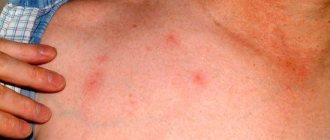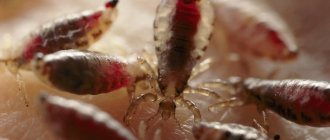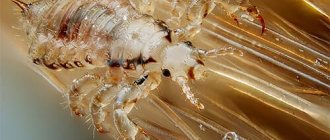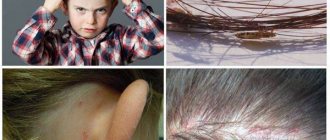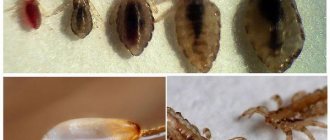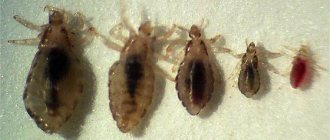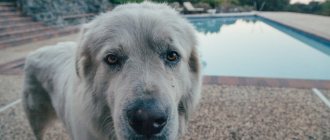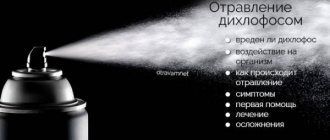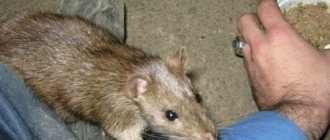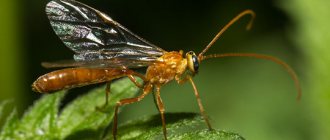Many people have parasitic microorganisms in their bodies. Some patients do not even suspect that they are carriers of the infection. Parasitic microorganisms can affect any part of the body. They can also affect the scalp. Such parasites bring a lot of discomfort to the patient. Let's find out what microorganisms can affect the scalp and whether hair can fall out due to parasites living in the body.
Parasites, in addition to various organs, can live in human hair
Appearance of lice
Parasites have a faded, whitish, and sometimes grayish color.
They have three pairs of legs. They are easy to notice visually on the scalp, but lice are very agile and are able to quickly move from one place on the head to another. Nits are the specific membranes in which lice eggs are located. They consist of a sticky substance, so they are quite difficult to separate from the hair. Any nit contains only one egg. As a rule, they are attached to individual hairs.
If a person has lice, the first thing you might notice is the nits. They are small oblong white balls that stand out especially against a dark background - dark hair.
When there are a huge number of lice on the hair, even after careful hygiene procedures, in particular, washing the scalp, it seems that small white grains have been scattered on the hair.
Features of the appearance of nits:
- The size of the nit is approximately one millimeter.
- Outwardly, it looks like a round and oblong ball.
- When examined under a microscope, you can notice the adhesive component in the shell.
It is worth noting that nits have a “small cap”, which, when the egg matures and turns into an adult, easily opens and releases parasites into the hair.
Who likes to parasitize under the scalp
Known parasites under the human scalp are mites. A microscopic scabies mite settles under the skin and begins to gnaw passages in it, thereby causing unbearable itching in humans (scabies disease). Favorite places are places with thin skin: hands, interdigital spaces, armpits; such a mite can also parasitize under the scalp. To get rid of this parasite, they use sulfur-tar ointment, special baths, and disinfect the patient’s clothes and bed.
In addition to ticks, filaria, guinea worms and other helminths can multiply under the skin, but these diseases are typical for countries with a hot, tropical climate and are very rare.
There are many parasites that can live in the brain tissue, on the scalp and under the skin . Each disease requires differential diagnosis and selection of treatment by a specialist.
Other articles in your language:
Fascioliasis, or disease caused by liver fluke
What signs of encephalitis occur after a tick bite in a person?
Symptoms, diagnosis and drug treatment of helminthiasis
What do worm eggs look like in humans and how to remove their “hosts”
What parasites are dangerous to humans, as well as about fish and cats
Distribution and reproduction
How do lice appear? In order for an insect to move onto the head, it must be in close contact with the contaminated surface. Contact can occur when using a comb, wearing hats, or sleeping on pillows. Such contacts especially often occur among children when visiting kindergartens and schools, since they, as a rule, are not attentive enough to personal hygiene.
It is believed that dirty hair is more conducive to the spread of parasites. This is wrong. Lice only care about blood; they do not feed on any other tissues of the body. A clean head and hair are just as attractive to insects.
The correlation between uncleanliness and the frequency of infection has another reason: people living in poor sanitary conditions are more likely to have physical contact with each other and use the same hygiene items, which increases the risk of disease.
The belief that a nervous condition makes infection more likely has no serious scientific basis.
But indirectly, stress can increase the risk of lice - nervous people sweat more often, and their immune system is weakened, which attracts insects.
Lice in the head begin to multiply immediately after settling. The female lays two to four eggs per day; during her entire adult life (a month), their number can reach 140 eggs.
It is not difficult to calculate that in a few weeks a colony of lice on the head can grow to such a scale that it becomes unbearable for a person to endure their vital activity with a high frequency of bites. In the early stages of the disease, only a few parasites live on the head, later their number reaches tens and even hundreds.
REFERENCE: Head lice live only on the surface of the head. There are no “subcutaneous lice” - these are scabies mites, which are often confused with the pathogens of lice because of their external similarity and the same way of feeding.
Fleas
Fleas primarily infest animal fur. But unlike lice, fleas do not live on humans or animals. They settle in houses and live on the ground. In multi-storey buildings, they first settle in the basements, and from there they move into apartments, making their nests in floor cracks, under baseboards, and in the carpet.
These insects are quite jumpy, and they jump on the donor to drink his blood. The parasite itself is not dangerous to humans, but its bite is quite painful and causes discomfort.
In rare cases, fleas provoke skin irritation and cause an allergic reaction. The immediate danger of this parasite to humans is that they are carriers of viral, often dangerous diseases. By the way, it is worth noting that lice are also capable of introducing infection into the body of their donor.
A flea lives on average three months. The female insect scatters eggs in small portions, in different habitats, and on the skin of donors. The development of eggs before they become larvae lasts about two weeks.
Fleas, like lice, live on all continents of the globe. But in contrast to lice, fleas are omnivores in the sense that almost all warm-blooded animals and birds become their donors.
To get rid of lice, you need to apply the medicine to your hair. A person does not need to be treated for fleas. It is enough to disinfect the premises and pets living next to people. The easiest way is to wipe dry floors with kerosene. Fleas, sensing the smell of kerosene, will leave your house on their own.
Special anti-flea collars have been developed for cats and dogs, which help pets feel calm and comfortable. There are also special anti-flea shampoos.
In conclusion, it should be recalled that in addition to ectoparasite insects, such as ticks, lice and fleas, hair loss can also be caused by the helminth bovine tapeworm. » alt=»»> » alt=»»>
Many people have parasitic microorganisms in their bodies. Some patients do not even suspect that they are carriers of the infection. Parasitic microorganisms can affect any part of the body. They can also affect the scalp. Such parasites bring a lot of discomfort to the patient. Let's find out what microorganisms can affect the scalp and whether hair can fall out due to parasites living in the body.
Causes and symptoms
Since parasites appear in places with poor sanitary and hygienic conditions, the main reason for their appearance is failure to comply with basic hygiene rules.
Lice can be transmitted through underwear or bedding, through hats and other personal items. An interesting fact, but lice can exist freely in open bodies of water, and even in a swimming pool where sanitary and hygienic requirements are not met. Swimming in them can cause you to become infected with lice.
In a number of situations, parasites can “hide” in the folds of clothing, where they lay their eggs; it is almost impossible to detect them. However, they crawl onto human skin to feed; in this case, areas of the skin such as the armpits, groin area, and back are affected, that is, in those places where clothing fits most closely to the human body.
Lice can also appear under the following conditions:
- Long journeys, trips when it is not possible to fully comply with hygiene rules.
- Seasonal work with large crowds of people.
- In children's institutions where children closely communicate and make contact.
- In other places where there are large crowds of people (sanatorium, hospital).
It is in such places that you should follow all the rules of hygiene and do not forget about preventive measures, which will avoid infection, thereby eliminating subsequent treatment.
As practice shows, the appearance of lice is quite difficult to notice. In some cases, parasites can manifest themselves immediately after a couple of days from the moment of infection; in other situations, they can remain on a person’s head for a couple of weeks, and there will be no signs of their presence.
As a rule, lice especially affect the back of the head and temples of a person's head. The following signs may be observed in this area:
- Severe itching sensations, as a result of which a person scratches the scalp, sometimes until blood appears.
- The affected parts of the head can fester, resulting in the formation of ulcers, boils and other pathological phenomena.
- With a prolonged course of the disease, the scalp becomes denser and pigment spots appear.
In good lighting, you can visually observe nits on human hair that are attached to them. Usually they are located as close as possible to the root structure of the hairline.
Ticks
Not many people know what parasites can live in hair, other than lice. Everyone should become familiar with the characteristics of such parasites. They can easily get on the body and bring a lot of discomfort. Demodex are microscopic parasites that belong to mites. Not only can they cause partial baldness, but they can also cause skin rashes and acne.
Demodex can carry out its life activities:
- in the area of hair follicles;
- on eyelashes;
- in the pores of the skin;
- on the eyebrows.
Ticks use skin secretions as food. That is why, to prevent illness, you need to carefully observe personal hygiene.
Most susceptible to infection:
- people who have oily hair type;
- people with skin rashes;
- people who often touch their faces with dirty hands.
Demodex often causes deterioration of the hairline and its loss. If there is a significant reduction in hair and it is impossible to get rid of the problem, you need to seek help from a trichologist. He will prescribe various tests. If demodex is present, the patient is usually recommended to use:
- Sea buckthorn oil. It allows you to destroy all existing parasite larvae on the skin and restores the affected areas.
- Shampoos that consist of natural ingredients. They do not disrupt metabolic processes and reduce the amount of sebum secreted.
Sea buckthorn oil is recommended to be applied to the scalp before starting the process of washing it. After cleansing your hair with natural shampoo, apply various essential oils. A trichologist can select them based on the individual characteristics of the patient.
Self-selected essential oils will not be effective. In some cases, they can only intensify the process of producing skin secretions. That is why, if you have symptoms, you need to consult a specialist.
Which parasites can live in the brain?
Most parasites enter the human body through the digestive tract. From there, they are carried throughout the body through the blood or lymph flow, but each of them has its own favorite localization sites.
The human brain is one of the vital structures that is well supplied with blood and the slightest malfunction in its functioning will immediately manifest itself in various symptoms. Not many parasites choose to live in the brain; cysticerci and echinococci are found there most often.
Cysticercosis
Cysticercosis of the brain is a parasitic disease caused by the ingestion of pork tapeworm (worm) larvae. These larvae are called cysticerci.
The disease develops when larvae of the pork tapeworm enter the digestive tract. Under the influence of gastric juice, the shell of the eggs dissolves, and they enter the brain tissue through the bloodstream, and less often into the eyes and muscles.
In the brain they turn into bubbles filled with colorless liquid. Most often, tens and hundreds of such bubbles are found in the brain, but single cysticerci are also found. Clinical signs of the disease:
- mental changes;
- paresis and paralysis;
- visual impairment;
- sleep problems;
- headaches and vomiting;
- convulsions, epileptic seizures, etc.
Symptoms and treatment of such parasites in the human head depend on their location and number. Anticonvulsants, hormones, and nonsteroidal anti-inflammatory drugs are used. If there are only a few accessible cysts, surgical intervention is performed and the parasites are removed. With widespread cysticercosis, the prognosis is very serious, since the disease can quickly lead to death.
Echinococcosis of the brain
This worm (echinococcus) does not often affect the brain, preferring to settle in the liver and other organs. Infection occurs when echinococcus enters the brain tissue, where it forms cysts of various sizes: from a small pea to the size of a fist. Clinical symptoms are similar to a brain tumor. The patient experiences vomiting, headaches, seizures and convulsions. Mental disorders and decreased mental abilities are noted.
Treatment is carried out surgically. If possible, remove the hydatid cyst. With numerous cysts, such removal is impossible and the prognosis for life is very unfavorable.
Demodex: causes and symptoms
Demodex is a mite that can live and parasitize on the human scalp, in the sebaceous glands and glands of the cartilage of the eyelids.
The parasite is small in size, not exceeding two tenths of a millimeter. The main symptom of the presence of the parasite is redness of the edges of the eyelids, with painful sensations present, the eyelids are constantly irritated and itchy. This condition intensifies at night, and it is very difficult to endure; sometimes there is discharge from the eyes - it can be mucus or a foam-like liquid.
Demodex in women can lead to a white coating on the eyelashes or their complete loss. In addition, patients complain of constant lacrimation, redness of the eyeballs, and a feeling of “garbage” in the eyes.
Demodex can appear in any person, for example, due to the abuse of cosmetics that contain hormones, or when the skin is damaged, as a result of which an infection gets into the wound.
If there is a high number of demodex mites in humans, the disease is characterized by the following symptoms:
- Acne and pink spots appear on the skin of the face.
- Itching in the hair.
- The skin of the face becomes lumpy and uneven.
- Individual symptoms - excessive expansion of pores on the nose, forehead, cheeks.
If the hair follicles are infected and treatment is not carried out, then over time the hair begins to fall out, and the person slowly but surely goes bald. It is worth noting that demodex, due to the release of a special substance, can provoke a malfunction in human metabolism.
There are two types of mites - one lives in the hair, and the second parasitizes the sebaceous glands. If the patient's eyes are affected, a microscopic examination of the eyelashes is performed. When there are lesions on the skin of the face characteristic of this parasite, a scraping is taken from the affected area.
Treatment of such a problem is difficult, and its duration can be up to six months. Treatment of the disease is aimed at the following goals:
- Increase the body's defenses, strengthen the human immune system.
- Eliminate parasitic microorganisms.
During therapy, antihistamines are prescribed to get rid of allergies. These can be a variety of ointments, gels or tablets. Treatment for mites on the face includes the following medications:
- Demalan (ointment) promotes increased tissue regeneration and is applied to the affected areas of the skin.
- Prenacid reduces the manifestations of an allergic reaction.
If a purulent manifestation of blepharitis has developed, the doctor recommends antibacterial medications. The most proven ones are Colbiotsin and Eubetal.
It is worth noting that you cannot get rid of such a mite on your own, and alternative medicine will not give the required effect, although there are options for treating demodex on the face at home, but they must be supported by traditional medicine.
Only the attending physician will draw up an adequate treatment regimen and help get rid of the problem.
Ways to fight
To get rid of bugs in your head, you can use various treatment methods. In the case of external parasites, you should purchase treatment products at the pharmacy. They are recommended for independent use. When diagnosing subcutaneous parasites, consultation with a specialist is required, who will prescribe a course of treatment based on the test results.
Treatment of pediculosis
You can get rid of these parasites in human hair using special anti-pediculosis agents. They can be in the form of shampoo, spray, lotion, repellent. To do this, you need to apply the composition to your hair and leave it for a certain time, according to the instructions. In this case, the head should be wrapped in plastic wrap. After time has passed, the product must be washed off, and then the parasites must be combed out with a fine-toothed comb. The procedures must be repeated regularly until all parasites are destroyed.
Effective remedies against head lice:
- Nyuda;
- Veda and Veda 2;
- Para Plus.
Couple Plus
Getting rid of fleas
To get rid of these small insects that can appear in the hair on the head, you should use similar remedies as against lice, but you should also treat your clothes first. To do this, you need to wash it at the highest possible temperature with the addition of special products. It is necessary to wash and iron bed linen, as well as exterminate fleas in the bed structure (including the mattress) and nearby furniture.
You can use the following:
- NOC;
- Medifox;
- Bubil;
- Pedilin.
Expulsion of subcutaneous parasites
For dirofilariasis, surgery is performed to remove the parasites from the human body. If necessary, drugs are pre-administered to immobilize it. Self-medication in this case is unacceptable.
Therapy for demodicosis
To get rid of parasites that live not in the hair, but under the skin, namely mites, qualified medical care is also necessary. The duration of treatment is usually 3 months. The doctor prescribes mainly topical medications, as well as medications to enhance the patient’s immunity. In case of secondary infection, antibiotics are also used.
Classification
Partial or complete baldness is caused by the following types of pathogenic organisms:
- Psoriasis or lichen is not infectious, caused by pathological processes inside the human body.
- Asbestos lichen, resulting from organ dysfunction.
- Fungi.
- Worms.
- Fleas.
- Lice.
- Ticks.
Fungus
There are several types of parasitic fungi that affect people's hair, causing hair loss. Fungal diseases are always infectious in nature, so you will have to disinfect all personal hygiene items. Let's look at the types of diseases:
- Microsporia is a fungal disease that causes hair loss. If several people live in a house, then the risk of re-infection is very high. In the process of inflammation of the skin, areas swell, the hair follicle weakens and, as a result, baldness appears.
- Scabs or yellow crusts on the skin. There is a small area of skin where there is no hair, some area is affected by crusts.
- Trichophytosis is a complex fungal pathology that causes complete hair loss. The disease is transmitted by contact. The lesion leads to brittle hair at the base, bare areas of skin become covered with plaque. The skin is hyperemic and swollen.
Fungi cause serious pathologies of internal organs. Only a qualified doctor can determine which fungus caused the skin lesion and prescribe the correct treatment regimen.
Fungus
Deterioration of the hair and scalp can also be associated with fungal diseases. The fungus can cause damage to the entire hair part. It most often occurs on the skin and mucous membranes. If you suspect an infectious disease, it is important to seek help from a medical facility. The doctor will tell you what consequences the fungus entails and how to get rid of it.
- Microsporia is a fungal disease that spreads quite quickly. Experts note that such an infection is instantly transmitted to all family members. That is why, if one person has a disease, all people who live in the same house with him should undergo treatment. When such a fungal disease occurs, the patient experiences partial hair loss. Some areas become completely bald. The scalp begins to actively peel off. This process, caused by a fungal disease, brings a lot of discomfort.
- Scab. With this parasitic disease, some areas of the patient's head become covered with a strong crust. Hair falls out, but not completely.
The danger of the presence of nits and lice in human hair
When settling in human hair, these insects and their eggs can cause a lot of trouble. The main diseases caused by pediculosis:
- Allergy, as a result of lice biological waste getting into wounds;
- Eczema;
- Dermatitis;
- Ulcers on the skin;
- Blepharitis of the eye;
- Relapsing fever;
- Pigmentation of the scalp in advanced forms.
Lice must be removed immediately. It will take several weeks to get rid of nits.
How long do lice live and how do they die?
As mentioned earlier, a louse can live for 38 days.
At the same time, she can live without food for only 10 days, if there are comfortable conditions for her existence. If the air temperature is more than 45 degrees, only then will the lice begin to die. These insects can live for a couple of days in cold water and this is how they get onto the human body when swimming in a river or pool.
When a person is shaved bald, lice will not be able to survive, since they have nowhere to hide and they will not be able to stick their offspring. Consequently, they will be discovered and destroyed.
There are drugs that can deal with lice in a couple of doses. These drugs will be discussed below. For now, let's look at the types of lice.
- Head louse
. It lives exclusively on the human head, in the hair. - Pubic louse
. This type is based on the human genitals (armpits, eyebrows, beard - all those genitals where there is hair). - Body louse
. Habitat: clothes and linen. It also feeds exclusively on human blood.
What's happened
Dandruff is a flaking of the skin underneath the hair. Its causes are malfunctions of the sebaceous glands or excessive drying of the skin. Of course, such manifestations do not pose a particular threat to the health of the owner, but they give the hair an unkempt and completely unnatural appearance.
Therefore, dandruff needs to be combated with various cosmetic methods and through proper nutrition.
They produce oily dandruff, which involves gluing of scales. Men and women experience severe scalp itching, and after washing, their hair looks dull and dirty. But there is one positive thing about this type of dandruff - it is hardly noticeable.
Important point! If oily dandruff covers large areas of the scalp, the scales begin to flake off and damage the curls. This situation can cause excessive hair loss.
The dry type of dandruff is accompanied by severe itching and the abundant appearance of white powder, which directly falls out of the hair at the slightest movement or combing.
The causative agent of severe peeling of the skin is Pityrosporum oval. This microorganism begins to actively multiply during malfunctions of the sebaceous glands, since favorable conditions are created for its existence.
The distinctive signs of dandruff are:
- small scales on the curls, which somewhat resemble white snow;
- peeling is noticeable on the scalp, accompanied by itching;
- hair color loses brightness and curls begin to fall out;
- hair acquires excessive gloss, becoming greasy (in some cases);
- if dandruff is not treated, the process of keratinization of the dermis becomes more intense, so the number of white grains increases;
- with a severely advanced form, dandruff spreads to the eyebrows and interlash space.
The appearance of dandruff is caused by the fact that little subcutaneous fat is secreted. Therefore, if you have dry skin, split ends and brittle hair, be prepared for dandruff.
It is important to distinguish dandruff from other dermatological diseases, namely:
- psoriasis, which appears along the edge of the hairline;
- ringworm, which has clear boundaries and local foci;
- streptoderma, which at first is very similar to dandruff, but over time manifests itself as ulcers and the formation of a yellow crust;
- seborrhea pemphigus.
Dandruff is very easy to confuse with lichen , especially at first. But over time, the latter turns into a circle or oval, at the location of which curls fall out and pus appears.
How to get rid of lice?
Pediculosis will not go away on its own. Over time, the number of insects increases, the number of bites increases, and the itching becomes constant and unbearable. Control methods are divided into two types - mechanical and chemical. Folk recipes can also be classified as chemical methods, but we will consider them separately.
Mechanical methods
Typically, mechanical methods mean hair cutting, shaving and combing out parasites with a comb, but they can also include thermal treatment with a hair straightener or tongs. Hair cutting at the root is the cheapest and most effective treatment method, but it is not suitable for everyone. Women and girls will not want to lose their hair, and not all men are ready to go bald.
Chemical and mechanical methods must be combined. Just treating with a drug from a pharmacy will not be enough; you need to comb out dead lice and their larvae from your hair. The fact is that most drugs are not capable of destroying nits; their shell reliably protects the offspring from chemical exposure.
Don't expect to get by with a regular comb. Nits must be combed out with a special comb with very frequent teeth located almost close to each other.
Chemicals
There are a large number of modern drugs for head lice; they differ in cost, consistency and method of application. The most common types of medicinal formulations can be distinguished:
- Shampoos are the most popular, inexpensive and quite effective products when used correctly and following all the procedures specified in the instructions. Here are some of them: Hygia, Paranit, Lavinal. Shampoos specifically designed for children are sold separately.
- Sprays are more effective than shampoos, but are more difficult to use, are difficult to wash off and can cause unwanted allergic reactions. Usually a comb is included. The most famous: Paranit, Lavinal, Nyuda, Para Plus.
- Aerosols used to treat contaminated clothing. Someone even uses Dichlorvos against lice.
- Creams are less common than shampoos and sprays, but they are not inferior to sprays in effectiveness. Among them: Nix, D-95.
- Combs - designed for combing out bloodsuckers. They differ from ordinary ones in that they have very frequent teeth that detach the nit from the hair using mechanical pressure. But this is an auxiliary product used in combination with chemicals, most often included with the product.
Linen lice are removed by thoroughly washing and ironing bedding or clothing. Temperatures above 60 and below -10 °C are destructive for parasites.
Life cycle of lice
In general, lice are quite tenacious.
They can adapt to any environment, be it hot or cold. Also, together with a person, they can stay under water for a long time. Surprisingly, nits (lice larvae) are much more tenacious than the lice themselves; even some chemicals do not kill them. They feed exclusively on human blood. When bitten, a person only feels itching and cannot even think that at that very moment a louse is biting him. Life expectancy is about 28 days. During this time, the female lays more than 200 eggs, and this carousel never ends.
When a person begins to fight lice, he pays close attention to this moment. That is why the fight against parasites takes about a month to overcome both adults and their offspring.
Size
Human dreams have a subtle connection with reality. Everything that seems frightening and bad in night dreams can in reality mean something good. If you dream of huge lice, so will your profit and success. If you see several large insects in your hair, a person gets a chance to make his dreams come true.
If the parasites are small, this portends favorable changes. A head full of parasites promises to overcome any difficulties. A person is ready to overcome any obstacles and go towards his goal. This is a favorable time for any endeavors.
How do lice reproduce?
In order for a female to become fertilized, one mating is enough and after that a “repeat procedure” is no longer required.
If one fertilized female gets on a person’s hair, then after a few days about a hundred nits will live on the hair. A few hours after fertilization, the female begins to gradually lay eggs on the human hair and tightly glue them to this same hair.
After a week or a week and a half, the upper lid of the egg bursts and a young nymph emerges from there. She immediately begins to suck blood, which leads to her reaching full maturity eight days later. If suddenly the nit does not find a food source, then within a day it will completely die from dehydration. Now imagine that hundreds of these nits live in your hair, constantly sucking your blood.
Prevention
Maintaining personal hygiene is the main principle of preventing disease. It is not recommended to use other people's combs or wear other people's hats. When visiting unfavorable places, insect repellent products are applied to the hair. During epidemiological periods of increased risk of infection, regular head examinations are carried out. Particular attention is paid to monitoring the condition of children's hair when they visit kindergartens and schools in the autumn and spring.
Thanks to this article, you learned what kind of disease this is - pediculosis, how lice get, and got acquainted with photos of lice and nits on the head.
Our website has many useful articles about pediculosis:
- Do lice grow on dyed hair - the specifics of selecting anti-pediculosis agents;
- how to remove nits and lice from long hair without resorting to a “zero” haircut?
- what to do if lice appear on your head? First and subsequent actions!
- a cloudy pool of your eyes, or lice on your eyelashes;
- what to use to combat parasites on the head: what are lice and nits afraid of?
Lice and pediculosis
A disease in which lice live in the hair is called pediculosis. A louse is a small blood-sucking insect. The disease can only be transmitted from a sick person to a healthy one.
Today, more than 100 varieties of such parasites are known. However, humans are affected by a certain subspecies, the transmission of which is impossible from different animals.
In addition to lice that live on the scalp, parasites are also known:
Lice is a rather unpleasant diagnosis. Such parasitic microorganisms are transmitted through direct contact between people. The greatest risk of head lice occurs in people who prefer long, flowing hair. This hairstyle is highly undesirable to use in children's educational institutions. Most often, lice are present in schoolchildren and preschoolers. You can become infected with pediculosis:
- when being in large groups;
- when visiting hairdressers;
- when visiting hotels;
- At school;
- in the camp;
- in kindergarten;
- when using other people's combs and hair bands;
- when using other people's bedding and towels.
Are there black nits?
Since an adult insect differs from larvae and eggs in having the ability to move quickly, it is difficult to visually detect the appearance of parasites. A characteristic external sign of lice infection is the appearance of black dots and nits on the hair, while the former are waste products of insects.
There are no black nits, since the color of parasite eggs can vary from white to gray, dark shades are excluded.
Useful tips
Having gotten rid of unwanted neighbors, it is important to follow preventive measures to prevent harmful insects from flooding the house again:
- maintain cleanliness;
- do not leave food supplies open, store food in tightly closed containers;
- use insect repellents (put them in cabinets and pantries).
Additionally, it is worth taking care of the “external” boundaries of the room: install mosquito nets, treat cracks and ventilation holes with poisonous insect repellents.
Diagnosis of pediculosis: how to independently detect the disease?
During the feeding process, the insect injects substances under the human skin that reduce sensitivity and prevent blood clotting, so during the bite the victim does not feel pain; unpleasant symptoms appear after some time. The following symptoms are characteristic of pediculosis:
- swelling of the lymph nodes;
- constant itching;
- the appearance of pustules on the skin;
- sleep disturbance;
- irritability.
Pediculosis can be diagnosed by detecting insects. At the initial stage of the disease, there are not many parasites yet, so inspection will require a fine-toothed comb. First, comb the hair in the usual way. When the comb slides freely along the entire length of the hair, you can use a comb.
In addition to the fact that lice cause significant discomfort to the victim, it is believed that they can infect a person with typhus or relapsing fever. They can, but it's very unlikely. There are currently no typhus epidemics, so there is no need to worry.
But lice can cause dermatitis and severe itching, which in rare cases can lead to allergic reactions and inflammation.
What do lice look like?
These parasites are microscopically small, barely reaching five millimeters in size. They have a clearly defined abdomen, but the head, on the contrary, is very small. They practically do not see, they keep their orientation solely by smell. Amazing fact: lice have wings, but they are also small in size and therefore they do not fly.
The oral apparatus of lice is of the piercing-sucking type with a proboscis and two needles. When a louse begins to feed on blood, its proboscis sticks out and attaches itself to a specific puncture site in the skin. When a bite occurs, saliva is released, which prevents blood clotting and subsequently causes itching on the human skin. Important point. Lice cannot completely penetrate human skin; only the proboscis gets there, which pumps out blood. They linger on the hair thanks to three pairs of legs, at the ends of which there are claws. Lice move at a speed of 20 centimeters per minute. It’s scary, but lice attach their nits, that is, larvae, to the hair on a sticky substance. With large fertilization, the female can lay several hundred eggs at a time. Hatching time is about sixteen days.
Where do lice live at home (apartment)
Body lice as a species have not been around for very long - they appeared at the same time as people began to cover their nakedness . It is noteworthy that it was the DNA of this insect that helped scientists establish the approximate date of the creation of clothing.
They cannot live in hair - their limbs are not tenacious enough for this. But these parasites feel quite comfortable on “stale” clothes. They can be found:
- in folds and pleating;
- in turns;
- under the seams;
- in your pockets.
Compared to head lice, they are more resilient and harder to detect, which makes their habitat more comfortable and safe. In addition, clothing maintains a much more stable microclimate than hair.
Can lice live in things, on clothes, bedding and pillows?
When the problem of lice arises again and again, it makes sense to check and treat everything that regularly comes into contact with human skin . All textile items, from bed linen to furniture upholstery, are quarantined.
But at the same time, it often happens that lice are confused with bedbugs and fleas. You can distinguish some parasites from others by the following characteristics:
- A louse, unlike a flea, is not capable of jumping.
- A bedbug, unlike a louse, can be seen with the naked eye.
Reasons for appearance
Insects enter a person’s home through windows and doors, on the owners’ clothes, climb through ventilation shafts, and penetrate cracks. Bugs are looking for a comfortable habitat: a warm place with plenty of available food.
If the apartment has a lot of food supplies that are in the public domain, as well as secluded places where you can hide from human eyes, bugs can settle in it. You should start fighting uninvited neighbors as soon as possible, as they multiply quickly.
Treatment of pediculosis in children
Once you have identified lice, you should think about what treatment for head lice to choose. Increasingly, parents are choosing pest control shampoos, but some opt for folk remedies.
On a note!
Not every drug from the pharmacy is suitable for a child. Children are sensitive to chemistry. A toxic product can cause severe allergies or burn the scalp.
If the disease is detected at an early stage, then a comb will help to cope with it.
Pharmacy products
Most often, the pediatrician prescribes a special anti-lice shampoo or spray for children. Before using it, you should read the instructions. It is better not to buy this product without a doctor's prescription. After all, a poisonous drug can poison a child.
The following medications are usually prescribed to children:
- NOC;
- Hygia;
- Nyx cream;
- Nuda spray;
- Para Plus remedy for lice and nits;
- Paranit;
- Veda shampoo;
- Lavinal;
- Full Marx.
On a note!
Nyuda is the only spray that can be used to treat children's hair. It does not contain insecticides and does not cause allergies.
After the first treatment, parents sometimes turn to the pediatrician because white lice remain in the head. But these are not the insects themselves, but their eggs. After seven days, the parasites will come out of them. Therefore, treatment with the drug is repeated after a week.
Nude product
Folk remedies
An effective insect repellent can be prepared in your own kitchen. The most commonly used recipes are:
- Hydrogen peroxide is mixed with water 1:1. The mixture is applied to damp hair. The head is wrapped in a bag and then a towel. After 40 minutes, the product is washed off.
- Tar soap is applied to wet hair, kept under the bag for 40 minutes, and then washed off.
- Vinegar 9% is diluted with water in a ratio of 1:3. Each strand is treated with vinegar solution. The head is covered with a towel and a scarf is put on top. After 40 minutes, the hair is washed.
Important!
It is prohibited to use kerosene or Dichlorvos to treat head lice in a child. These products can cause severe burns and poisoning.
Special comb
A lice comb helps get rid of insect nits. It is used both after pediculosis has been recognized and for the purpose of preventing the disease.
Before combing out lice and nits, it is recommended to treat the hair with water and citric acid: 5 g of powder per 250 ml of warm water. The composition softens the sticky mass, with the help of which the nit is attached to the hair and lice eggs become easier to comb out.
Fine-tooth comb
Review
I treated the child’s head with everything. The insects appeared again and again. The pediatrician advised me to purchase a special lice comb. They managed to comb out the nits, and the lice no longer bothered us.
Larisa, Ekaterinburg
The comb also helps to determine whether a child has lice. If nits and insects remain on it, then it is worth checking your hair and treating your head with an anti-parasite product. Hair is combed 4 times a day for 5 days. After combing, the comb is washed and treated with alcohol.
Black bugs in the apartment: who are they?
Black insects of various types are found in apartments:
- Khrushchak or flour beetle. The insect received its second name because of its love for flour and cereals. These are small bugs with different colors: large beetles are black-brown, small beetles are brown, black beetles are black (or very dark) in color. Large beetles reach a size of 10-12 mm, and black ones reach about 5 mm. Khrushchak eats and spoils not only food, but also clothing with excrement.
- Kozheed. Bugs with a body 3-4 mm, often black. They feed on fur and leather products (for which they got their nickname). They settle in closets, in stacks of rarely used clothes or linen, and carpets. Carpet beetles also eat grain, flour, cereals and nuts, and will not refuse meat and fish. They eat house plants, books, and furniture upholstery.
- Midges. They often grow in potted plants with constantly moist soil. They also love spoiled food and stale water. They get into food and drinks, can destroy flowers, and bite quite painfully.
READ ALSO: Common silverfish in the bathroom: how to get rid of the small gray insect and where it comes from
The beetle beetle and the beetle beetle are especially dangerous, as they can ruin a lot of food and property. These small black bugs lay large numbers of voracious larvae, which quickly grow into full-fledged individuals.
Learn how to properly sew up a hole in a T-shirt, neatly and discreetly.
How to lubricate door hinges to prevent them from squeaking? Read useful recommendations at this address.
Red dandruff (dermatitis)
Red dandruff is called so conventionally. In fact, this is nothing more than particles of epithelium that fall from an area of skin affected by fungus or dermatitis. Why is it red? Because the irritated area becomes inflamed, causing discomfort and, often, itching.
Scratching the area will only make the problem worse, as scratches and deep depressions in the affected area are a quick easy way for other infections.
The reasons for this are as follows:
- Fungal diseases.
- Predisposition.
- Unbalanced diet.
- Frequent stress.
- Lack of sleep and excessively long sleep.
- Alcohol consumption.
Getting rid of parasites
Hitting malicious insects on your own body in a dream means victory over troubles. Luck is on the dreamer's side. Any thoughts and actions of hostile individuals will be ineffective. Combing parasites out of your head means getting rid of problems. Pests leave a person’s head, and his life becomes easier and happier. This interpretation is given to dreams in which fleas are combed out from oneself or from other people.
Catching, squeezing with your hands and killing parasites means an improvement in your financial condition and positive changes in your work. The interpretation is true if the dreamer is a man. If another person succeeds in killing an insect on the head, someone from the environment will become successful.
Some dream books claim the opposite. The English interpreter says that intentionally killing parasites leads to negative changes. If you dream that you are crushing lice, your significant other or close friend will betray you.
What do they eat?
Lice feed exclusively on blood (mainly human), their oral apparatus is adapted specifically to pierce the skin and pump out blood. Other power sources are not available to them. They cannot feed on hair, skin or dandruff as some people believe.
Lice feed about 5 times a day every 2-3 hours. In one suction, a louse can drink approximately 0.5 mg of human blood. Saturation with blood allows parasites to reproduce and lead an active life.
Parasites lay eggs close to the skin. How long do nits live? The incubation period before lice hatch from the egg is about 10 days. Females require blood feeding to reproduce. Nits do not need nutrition, since their shell contains all the necessary nutrients. A constant ambient temperature is very important for egg maturation. The scalp provides the ideal level of warmth that allows lice to develop and hatch.
After this, the cocoon shells remain on the hairs, and the lice begin to feed, biting through the human skin. From the moment the larva emerges from the nit until the louse reproduces independently, nine days pass. The louse can move to other people from the tenth day of life. Parasites live on average about 30 days, during which time they lay from 100 to 300 eggs.
People actively destroy parasites using pharmaceutical and folk remedies, but insects can also die from natural enemies. In nature, they are threatened by certain types of ticks, false scorpions.
Demodex mite
The second most common mite after lice is the Demodex mite. Its Russian name is ironclad. Medicine knows two types of mites that parasitize human hair:
- Demodex folliculorum.
- Demodex brevis.
These parasites are also called eyelash mites. They often settle for centuries. Unlike lice, which live on the outside of the hair and release their eggs directly onto the hair, Demodex folliculorum lives inside, in the hair follicles, and Demodex brevis lives in the sebaceous glands.
These parasites are much smaller than lice and are invisible to the naked eye. However, according to doctors, between half and two-thirds of the population are infected with demodex. The mite eats skin cells, hormones, nutrients, and sebaceous gland fats, thereby weakening hair and contributing to hair loss. At night, the parasite comes out and walks on the donor’s head and hair.
Eyelash mites live for several weeks. During this time, they manage to mate several times and produce offspring. 3 days after laying the eggs, the larva hatches, which turns into an adult within a week.
In most cases, mites do not manifest themselves in any way, but if the immune system is weakened, the skin disease demodicosis may appear. In the treatment of this disease, the drug Spregal has a good therapeutic effect. The product is rubbed into the skin in the affected areas.
There are more than 40 thousand ticks in nature. But only a few of them are parasites of warm-blooded animals that live in human hair and skin, causing hair loss, dermatitis, and itching. These parasites also live in animals.
Dreamer
Lice promise a man success in his career
The fact that lice dream of money is not always true. The gender and position of the dreamer matters:
- Pregnant woman. Seeing parasites in your hair means profit. Squeezing them means health problems. It is better for the expectant mother to consult a doctor.
- Married woman. Dreaming of a louse in your hair means your significant other is cheating. There is another meaning - the need to pay attention to hobbies and creativity.
- Unmarried girl. If a girl is lonely, such a dream will mean fear of meeting a young guy. If a girl is in a relationship, it means she needs to share her fears and secrets with her other half.
- Man. Such a dream symbolizes favorable changes in your career, success in business, and more money.
Having seen lice in a dream, you will need to figure out what type of parasites they were. This also affects the interpretation.
Worm infestation
Can worms cause hair loss? With a strong proliferation of worms in the human body, a decrease in protective functions (immunity) occurs, which indirectly can provoke thinning of the hairline: the hair begins to fall off. In addition to thinning hair, other undesirable changes occur in the human body.
However, trichologists claim that hair loss can be caused not by all worms, but only by bovine tapeworm. Infection with tapeworm not only changes the microflora in the intestines, but also negatively affects the composition of the blood. A decrease in the protein components of the bloodstream leads to baldness.
Neither the presence of lice nor the presence of worms in the human body are the causes of thinning hair. However, a decrease in the body's protective functions can lead to significant hair loss. This should be remembered.
How to protect yourself from bovine tapeworm and other worms? To do this you need:
- always wash your hands with soap;
- do not eat poorly cooked meat;
- treat pets for worms.
Hair loss
People often complain about active hair loss. They often suspect that this is due to the activity of some parasitic microorganisms in the head area. Hair loss is often caused by lice. Sometimes this symptom appears due to worms. However, having such a problem, many begin to change hair care products, without even suspecting that it is associated with more serious pathologies.
Worms living in the body significantly reduce the body's immune defense. This can cause active hair loss. Experts note that the occurrence of such symptoms is associated with the presence of bovine tapeworm in the body.
- disrupts intestinal microflora;
- changes the composition of the patient’s blood;
- weakens the human immune system.
A person with bovine tapeworm will experience the following symptoms:
- weakness;
- dizziness;
- prostration;
- change in bowel habits (constipation or diarrhea);
- causeless increase in temperature;
- lack of appetite;
- change in body weight.
If you experience hair loss and the presence of these symptoms, you should seek help from a medical facility. The doctor will conduct an initial examination and direct you to undergo certain tests. In order to protect yourself from the occurrence of such a parasite, you must:
- do not eat raw or poorly cooked meat;
- carry out prevention of worms in pets;
- Wash your hands thoroughly regularly.
